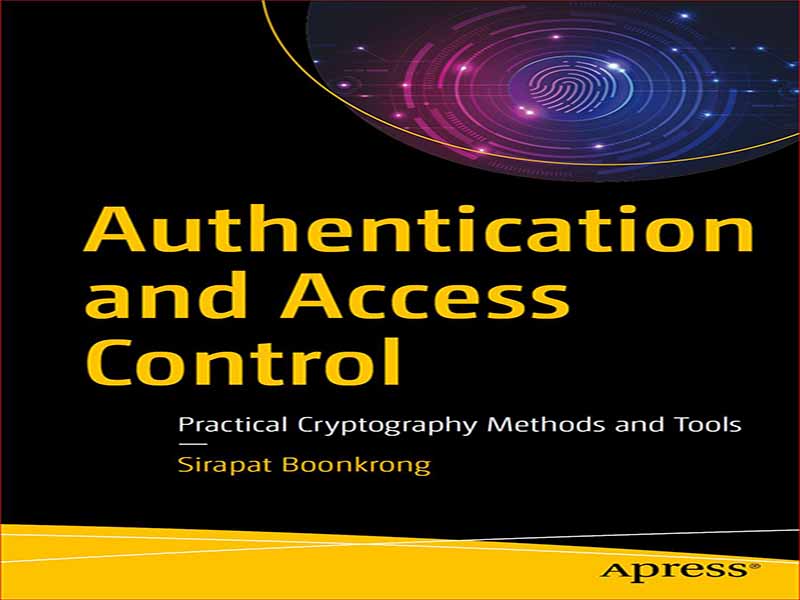- عنوان: Authentication and Access Control – Practical Cryptography Methods and Tools
- نویسنده: Sirapat Boonkrong
- حوزه: کنترل دسترسی
- سال انتشار: 2021
- تعداد صفحه: 242
- زبان اصلی: انگلیسی
- نوع فایل: pdf
- حجم فایل: 6.59 مگابایت
ظهور اینترنت به بسیاری از خدمات و برنامه های کاربردی اجازه داده است، به ویژه در ارتباطات بین کاربران، سرورها و دستگاه ها. متأسفانه این امر منجر به چالش ها و مشکلات امنیتی بسیاری شده است. نمونه های اخیر شامل نشت رمز عبور در سایت های شبکه های اجتماعی بزرگ و تخریب وب سایت ها است. بنابراین، مطالعه مکانیسم هایی که به کاهش خطرات انواع مختلف حملات کمک می کند، ضروری است. یکی از این مکانیسم ها کنترل دسترسی است که فرآیندهای رمزنگاری، احراز هویت و ایجاد کلید را اعمال می کند. بنابراین، این کتاب با تلاش برای ارائه یک پوشش جامع در مورد مکانیسم های احراز هویت نوشته شده است. این کتاب برای هر کسی که مایل به درک اصول اساسی رمزنگاری و اینکه چرا آنها بخش مهمی از مکانیسم های احراز هویت را تشکیل می دهند در نظر گرفته شده است. علاوه بر این، تئوری ها و نمونه هایی از فناوری های احراز هویت موجود را در اختیار خوانندگان قرار می دهد که نویسنده امیدوار است در عمل مفید و قابل انطباق باشد. با این حال، این کتاب راهنمای پیکربندی شبکه یا سیستم نیست. احراز هویت و کنترل دسترسی: روش ها و ابزارهای رمزنگاری عملی را می توان به طرق مختلف مورد استفاده قرار داد. می توان از آن به عنوان مرجع خود مطالعه استفاده کرد. همچنین می تواند به عنوان یک کتاب کمک درسی برای دروس امنیت شبکه های کامپیوتری و امنیت اطلاعات استفاده شود. هر فصل از کتاب شامل توضیح مفصلی از موضوع و نمودارهایی برای کمک به توضیح است. مطالب و مطالب این کتاب از منابع مختلف از جمله مقالات تحقیقاتی کلاسیک و جدید، سایر کتابهای درسی و همچنین تحقیقات خود نویسنده گردآوری شده است. نویسنده امیدوار است که این کتاب برای خوانندگانی که مایل به کسب اطلاعات بیشتر در مورد احراز هویت هستند مفید باشد. این کتاب در هشت فصل تنظیم شده است که همه آنها پس از بررسی گسترده ادبیات و تحقیقات خود نویسنده و همچنین تجربیات تدریس نوشته شده است. آنچه از خوانندگان انتظار می رود در هر فصل بیابند به شرح زیر است: فصل 1، مقدمه ای بر رمزنگاری، اصول اساسی رمزنگاری را پوشش می دهد، که بخشی از مکانیسم های احراز هویت را تشکیل می دهد. این فصل در این کتاب گنجانده شده است زیرا قبل از ورود به جزئیات مکانیسم های احراز هویت، لازم است اصول اولیه رمزنگاری را درک کنید. فصل 2، زیرساخت کلید عمومی، مکانیزمی را معرفی میکند که امروزه اساس امنیت تراکنشهای اینترنت در نظر گرفته میشود. همچنین شامل نحوه انجام احراز هویت قبل از ایجاد یک کانال ارتباطی امن است. فصل 3، روش ها و تهدیدات احراز هویت، سه روش اصلی احراز هویت و همچنین برخی از روش های موجود دیگر را توضیح می دهد. تهدیدهای مربوط به مکانیسم های احراز هویت نیز مورد بحث قرار می گیرد. فصل 4، احراز هویت مبتنی بر رمز عبور. رمزهای عبور محبوب ترین و رایج ترین مکانیسم احراز هویت هستند. بنابراین، درک انواع رمزهای عبور و تئوریهای مربوط به تولید رمز عبور ضروری است. این فصل همچنین اصول روش های ذخیره رمز عبور ایمن را مورد بحث قرار می دهد. فصل 5، احراز هویت بیومتریک، شامل بحث در مورد مراحل احراز هویت بیومتریک به همراه چگونگی اندازهگیری کارایی روشهای احراز هویت مبتنی بر بیومتریک است. این فصل همچنین به مشکلات بیومتریک، به ویژه مقدار آستانه می پردازد. در نهایت روش و مثالی برای یافتن آستانه بیومتریک مناسب نشان داده شده است. فصل 6، احراز هویت چند عاملی، مکانیزمی را توضیح می دهد که به عنوان احراز هویت چند عاملی شناخته می شود. مدتی است که احراز هویت تک عاملی به عنوان روش اصلی احراز هویت استفاده می شود. با این حال، بدون هیچ مشکل امنیتی ارائه نمی شود. احراز هویت چند عاملی زمانی است که بیش از یک روش یا یک نوع اعتبار احراز هویت در فرآیند احراز هویت استفاده می شود. به طور فزاینده ای در تأیید هویت کاربر برای دسترسی به سیستم های اطلاعاتی استفاده می شود. در این فصل اصول و نمونه هایی از پروتکل های احراز هویت چند عاملی توضیح داده می شود. فصل 7، پروتکلهای احراز هویت و استقرار کلید، رابطه بین احراز هویت و پروتکلهای ایجاد کلید را توضیح میدهد. برخی از پرکاربردترین پروتکلهای احراز هویت، از جمله پروتکلهایی که رمزنگاری متقارن را اعمال میکنند و پروتکلهایی که رمزنگاری نامتقارن را اعمال میکنند، در اینجا ارائه شدهاند. علاوه بر این، پروتکلهای احراز هویت کلاسیک و ایجاد کلید مورد مطالعه قرار میگیرند تا آسیبپذیریهای مشابه در آینده تکرار نشوند. علاوه بر این، دستورالعمل های اساسی برای طراحی یک پروتکل احراز هویت نیز در این فصل ارائه شده است. فصل هشتم، روندهای فعلی و آینده، فصل پایانی این کتاب است. این فصل تلاش میکند به آینده نگاه کند تا ببیند فرآیند احراز هویت چگونه تکامل مییابد و توسعه مییابد. دو تا از فرآیندهای آتی احراز هویت پیوسته و احراز هویت قابل لغو است…
The advent of the Internet has allowed for many services and applications, most notably in communications between users, servers, and devices. Unfortunately, this has led to many security challenges and problems. Recent examples include password leakage on large social network sites and defacement of websites. It is, therefore, necessary to study mechanisms that help reduce the risks of different types of attacks. One of those mechanisms is access control, which applies the processes of cryptography, authentication, and key establishment. Thus, this book is written with an attempt to provide a comprehensive coverage on the subject of authentication mechanisms. The book is intended for anyone wishing to understand the basic principles of cryptography and why they form an important part of authentication mechanisms. In addition, it provides readers with theories and examples of existing authentication technologies, which the author hopes will be useful and adaptable in practice. However, this book is not a manual for network or system configurations. Authentication and Access Control: Practical Cryptography Methods and Tools can be used in many ways. It can be used as a self-study reference. It can also be used as a supplementary textbook for computer network security and information security courses. Each chapter of the book consists of a detailed explanation of the topic and diagrams to aid the explanation. Materials and contents in this book are gathered from various sources, including classic and recent research papers, other textbooks, as well as the author’s own research. The author hopes that this book will prove useful to readers who wish to learn more about authentication. The book is divided into eight chapters, all of which are written after an extensive review of literature and the author’s own research as well as teaching experiences. What readers are expected to find in each chapter are as follows: Chapter 1, Introduction to Cryptography, covers the basic principles of cryptography, which forms a part of authentication mechanisms. This chapter is included in this book because it is necessary to understand the basic principles of cryptography prior to getting into the details of authentication mechanisms. Chapter 2, Public Key Infrastructure, introduces a mechanism that is considered the foundation of security for the transactions on the Internet today. It also includes how authentication is carried out prior to creating a secure communication channel. Chapter 3, Methods and Threats of Authentication, explains three main authentication methods as well as some other existing ones. Threats to authentication mechanisms are also discussed. Chapter 4, Password-Based Authentication. Passwords are the most popular and most commonly used authentication mechanism. It is, therefore, necessary to understand different types of passwords and theories behind password generation. This chapter also discusses the principles of secure password storing methods. Chapter 5, Biometric Authentication, includes the discussion of biometric authentication steps together with how the efficiency of biometric-based authentication methods can be measured. This chapter also touches on the problems of biometrics, especially the threshold value. Finally, a method and an example for finding a suitable biometric threshold are illustrated. Chapter 6, Multi-factor Authentication, explains a mechanism known as multi-factor authentication. One-factor authentication has been applied as the main authentication method for some time. It, however, does not come without any security issues. Multi-factor authentication is when more than one method or one type of authentication credential is used in the authentication process. It is increasingly used in verifying a user’s identity to access information systems. This chapter provides an explanation of the principles and examples of multi-factor authentication protocols. Chapter 7, Authentication and Key Establishment Protocols, explains the relationship between authentication and key establishment protocols. Some of the most widely used authentication protocols, including the ones that apply symmetric cryptography and the ones that apply asymmetric cryptography, are provided here. In addition, classic authentication and key establishment protocols are studied so that the same vulnerabilities will not be repeated in the future. Furthermore, basic guidelines for designing an authentication protocol are also presented in this chapter. Chapter 8, Current and Future Trends, is the final chapter of this book. The chapter attempts to look into the future to see how the authentication process will evolve and be developed. Two of the upcoming processes are continuous authentication and cancellable authentication…
این کتاب را میتوانید بصورت رایگان از لینک زیر دانلود نمایید.
Download: Authentication and Access Control




































نظرات کاربران